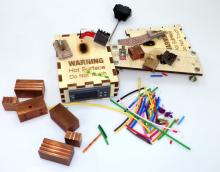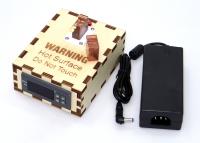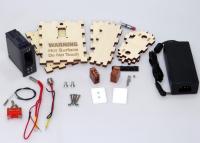Filament Splicer
Project cancelled, click here to read why
The idea for Filament Splicer was born about a month after our Ultimaker 3D Printer was build. As cool as 3D Printing is, printing in one color is boring.
Users of normal, single head FFF/FDM printers are stuck with single color unless they join filament pieces together to produce one multi-colored string. It is not very complicated but process is quite awkward and you will get fed up very quickly.
If you want to have proper, stable filament join you need to have right temperature on the tip of plastic when you connect pieces together. This is hard to achieve when you use some arbitrary heat source. You either underheat or overheat and burn the plastic. Using print head of your printer is best 'ad-hoc' solution but it leaves quite a mess on it, you cannot print when you splice and plastic which is in the head slowly gets burned while you take time to splice your string.
Then, of course there is issue with forming of the joint, carpet knife and fingers where our favorite tools for that job but it took quite a long time to form each joint.
We have had our share of failed prints due to broken joints / stuck filament and finally decided to create a device which will help to splice filament. Initial idea was to create fully automated unit: you place filament ends on copper block, close it, push the button and viola - you have your joint. That was the theory.... In practice this is impossible because PLA and ABS expand during heat-up and contract during cool down, this results in either no joint at all or bubble-filled mess.
Many headache filled days [Even best PLA is really nasty stuff when you breath it in for a while] later we dropped the idea and went for 'open' model with precisely manufactured grooves which help to quickly heat up, connect and form joints.
Thermal insulation was another challenge, we wanted to allow up to 260c temperature but nothing could properly insulate enclosure from hot copper block for prolonged period of time. Ceramic fiber thermal tape can take that heat but one needs a lot of it and then there is itching... Chinese tape is horrible and even best branded, made in USA [ThermoTec] tape is not flawless. We eventually gave up on ceramic fibre and went with PFTA [Teflon] plates. Since PFTA can be outright poisonous at high temperatures, we decided to use high quality - made in Europe material - this way we are sure that maximum temperature of 235c is well within safety limit.
Availability
Filament splicer can be pre-ordered via our campaign on Indiegogo, it is available as a DIY kit or fully assembled unit.
Open Source
Filament splicer blueprints are released under Creative Commons Attribution-NonCommercial 4.0 International License and can be downloaded from Thingiverse and Youmagine.





75757 Comments
UsewPoummausele hbjbi
Tolikvam (not verified)
onSun, 04/06/2025 - 15:39
Permalink
dark market link [url=https://github.com/abacuslink4jjku/abacuslink ]dark market link [/url]
Купить Тэнк - только у нас вы найдете цены ниже рынка.
ShermSoato (not verified)
onSun, 04/06/2025 - 15:46
Permalink
Заказать Танк - только у нас вы найдете разные комплектации. Быстрей всего сделать заказ на автомобиль танк комплектация можно только у нас!
[url=https://tankautospb.ru]официальный дилер танк в спб[/url]
танк спб автомобили - [url=http://tankautospb.ru]http://tankautospb.ru[/url]
Kuhni228
Kuhni228Mergo (not verified)
onSun, 04/06/2025 - 15:52
Permalink
[url=https://kuhnimixx.ru/]Кухни на заказ[/url] — это идеальное решение для нестандартных помещений и уникального дизайна. Максимум удобства и стиль под вас.
UsewPoummausele ndagc
PingGuite (not verified)
onSun, 04/06/2025 - 16:00
Permalink
dark web marketplaces [url=https://github.com/aresonioncq0a7/aresonion ]onion dark website [/url]
zithromax 500 price
RichardMed (not verified)
onSun, 04/06/2025 - 16:07
Permalink
https://lisinexpress.com/# lisinopril prinivil zestril
UsewPoummausele ovmhf
Rabyadest (not verified)
onSun, 04/06/2025 - 16:08
Permalink
darknet links [url=https://github.com/darkwebsitesyhshv/darkwebsites ]dark web drug marketplace [/url]
how can i get clomid no prescription
MichaelWaH (not verified)
onSun, 04/06/2025 - 16:09
Permalink
buy generic zithromax no prescription: <a href=" https://zithpharmonline.shop/# ">ZithPharmOnline</a> - buy zithromax 1000mg online
VPN i749r
IanWhish (not verified)
onSun, 04/06/2025 - 16:32
Permalink
Абсолютно с Вами согласен. Мне нравится эта идея, я полностью с Вами согласен.
ssl [url=http://pasarinko.zeroweb.kr/bbs/board.php?bo_table=notice&wr_id=5299285]... allows devices connected to web to create a secure remote vpn network with remote access using a web browser. So, what is the purpose of a vpn?
UsewPoummausele zvytr
DonDonboult (not verified)
onSun, 04/06/2025 - 16:50
Permalink
darkmarket url [url=https://github.com/nexusdarkrtv1u/nexusdark ]dark markets 2025 [/url]
UsewPoummausele gqagq
Donaldexpox (not verified)
onSun, 04/06/2025 - 17:33
Permalink
darknet market list [url=https://github.com/aresmarketdarknetl9khn/aresmarketdarknet ]darkmarkets [/url]
Select your country of residence and currency
BrandonSOw (not verified)
onSun, 04/06/2025 - 17:37
Permalink
Regardless of whether you are located in any other country, you will need to register to place bets at this establishment <a href="https://victor-habitat.com/">https://victor-habitat.com/</a>
Select your country of residence and currency
BrandonSOw (not verified)
onSun, 04/06/2025 - 17:37
Permalink
Regardless of whether you are located in any other country, you will need to register to place bets at this establishment <a href="https://www.aviator-game-bonus.com/">https://www.aviator-game-bonus.com/...
casino z330q
JamarcusEvity (not verified)
onSun, 04/06/2025 - 17:42
Permalink
Да, я вас понимаю. В этом что-то есть и мысль отличная, согласен с Вами.
the rules of the gameplay according to the criterion “penny-ante", when "the winnings of each visitor in a single a round, a [url=http://rtistrees.com/groups/katana-spin-casino/]http://rtistrees.com/gro... hand, or a game does not exceed 10 bucks”.
UsewPoummausele beasw
PingGuite (not verified)
onSun, 04/06/2025 - 17:53
Permalink
darknet markets [url=https://github.com/aresonioncq0a7/aresonion ]darknet marketplace [/url]
UsewPoummausele acfca
Tolikvam (not verified)
onSun, 04/06/2025 - 18:01
Permalink
darknet markets onion [url=https://github.com/abacuslink4jjku/abacuslink ]darknet markets onion address [/url]
can you get clomid for sale
BrianAmito (not verified)
onSun, 04/06/2025 - 18:17
Permalink
prednisone without prescription medication [url=https://predpharmnet.shop/#]prednisone 20 mg generic[/url] Pred Pharm Net
Bonus PrimeXBT s457e
Johnfleve (not verified)
onSun, 04/06/2025 - 18:18
Permalink
Bu 24 saat hizmet sizin icin zaten gerekmeyecek uzun beklemek oldugunu garanti eder|garanti eder} [url=https://staging.tforcesys.com/?p=65760]https://staging.tforcesys.com/?p=..., ozellikle/ozellikle kritik ticaret anlar?nda.
UsewPoummausele hlebm
Rabyadest (not verified)
onSun, 04/06/2025 - 18:29
Permalink
darkmarket [url=https://github.com/darkwebsitesyhshv/darkwebsites ]dark market [/url]
where can i buy cheap clomid online
MichaelWaH (not verified)
onSun, 04/06/2025 - 18:32
Permalink
AmOnlinePharm: <a href=" http://amonlinepharm.com/# ">ampicillin amoxicillin</a> - amoxicillin cost australia
casino f443o
Mariamig (not verified)
onSun, 04/06/2025 - 18:41
Permalink
Согласен, эта мысль придется как раз кстати
in whatever point of the planet user are staying on earth of our California hotel and [url=https://thaisugarcompanyltd.com/pocket-option-online-your-gateway-to-suc..., whether you are sunbathing with a cocktail by the oasis pool or Enjoy a glass of red wine from the Cielo wine cellar, enjoy the limitless views of the surrounding Morongo canyons, and enjoy the power and beauty of this unsurpassed oasis in Southern California.
prednisone 2.5 tablet
Lancesussy (not verified)
onSun, 04/06/2025 - 19:01
Permalink
ZithPharmOnline: <a href=" http://zithpharmonline.com/# ">can you buy zithromax over the counter in mexico</a> - ZithPharmOnline
UsewPoummausele prtit
DonDonboult (not verified)
onSun, 04/06/2025 - 19:12
Permalink
darkmarket link [url=https://github.com/nexusdarkrtv1u/nexusdark ]dark market list [/url]
zithromax 600 mg tablets
RichardMed (not verified)
onSun, 04/06/2025 - 19:20
Permalink
http://amonlinepharm.com/# buy cheap amoxicillin
Select your country of residence and currency
BrandonSOw (not verified)
onSun, 04/06/2025 - 19:30
Permalink
Regardless of whether you are located in any other country, you will need to register to place bets at this establishment <a href="https://cricmod.com/">https://cricmod.com/</a>
Select your country of residence and currency
BrandonSOw (not verified)
onSun, 04/06/2025 - 19:45
Permalink
Regardless of whether you are located in any other country, you will need to register to place bets at this establishment <a href="http://avivac.com/media/pgs/promokod_1xbet_kazino.html">http://avivac.co...
UsewPoummausele vtasf
PingGuite (not verified)
onSun, 04/06/2025 - 19:47
Permalink
dark web link [url=https://github.com/aresonioncq0a7/aresonion ]darknet market [/url]
Select your country of residence and currency
BrandonSOw (not verified)
onSun, 04/06/2025 - 19:50
Permalink
Regardless of whether you are located in any other country, you will need to register to place bets at this establishment <a href="https://koz-salon.ru/wp-content/pgs/promokod_melbet_kazino.html">https:/...
UsewPoummausele ksrlv
Donaldexpox (not verified)
onSun, 04/06/2025 - 19:56
Permalink
dark markets 2025 [url=https://github.com/aresmarketdarknetl9khn/aresmarketdarknet ]dark web market list [/url]
UsewPoummausele sdjia
Tolikvam (not verified)
onSun, 04/06/2025 - 20:24
Permalink
darknet market list [url=https://github.com/abacuslink4jjku/abacuslink ]darknet sites [/url]
generic prednisone tablets
Lancesussy (not verified)
onSun, 04/06/2025 - 20:32
Permalink
ZithPharmOnline: <a href=" http://zithpharmonline.com/# ">buy zithromax 1000mg online</a> - zithromax 500
amoxicillin 500 mg cost
DanielZor (not verified)
onSun, 04/06/2025 - 20:35
Permalink
AmOnlinePharm: <a href=" https://amonlinepharm.com/# ">AmOnlinePharm</a> - canadian pharmacy amoxicillin
amoxicillin online canada
DanielZor (not verified)
onSun, 04/06/2025 - 20:45
Permalink
AmOnlinePharm: <a href=" https://amonlinepharm.com/# ">AmOnlinePharm</a> - AmOnlinePharm
UsewPoummausele yxizw
Rabyadest (not verified)
onSun, 04/06/2025 - 20:51
Permalink
darknet markets url [url=https://github.com/darkwebsitesyhshv/darkwebsites ]darknet market list [/url]
trading bot d517s
Natalykak (not verified)
onSun, 04/06/2025 - 20:55
Permalink
жжет чертяга!!!
Which is the best [url=https://aquaacademy.az/should-you-be-worried-about-fluoride-in-your-wate... for crypto trading? The platform's telegram channel counts above 70,000 subscribers and possesses high rating in the crypto space.
cost of stem cells b173t
ShellyTem (not verified)
onSun, 04/06/2025 - 21:14
Permalink
headache and fatigue: Some patients complain of headaches and feeling tired after the procedure. Financing options are also available through medical companies that deal with to finance the [url=http://legufotografie.de/hallo-welt/]http://legufotografie.de/hallo-welt..., what contain loans specifically for medical treatment.
get generic clomid no prescription
BrianAmito (not verified)
onSun, 04/06/2025 - 21:18
Permalink
zithromax 500 mg [url=https://zithpharmonline.com/#]zithromax generic cost[/url] ZithPharmOnline
where can i buy generic clomid without a prescription
MichaelWaH (not verified)
onSun, 04/06/2025 - 21:20
Permalink
ZithPharmOnline: <a href=" https://zithpharmonline.com/# ">zithromax online pharmacy canada</a> - can i buy zithromax online
UsewPoummausele rtssc
DonDonboult (not verified)
onSun, 04/06/2025 - 21:35
Permalink
darknet drug links [url=https://github.com/nexusdarkrtv1u/nexusdark ]dark market list [/url]
UsewPoummausele rvuqc
PingGuite (not verified)
onSun, 04/06/2025 - 21:41
Permalink
darknet markets links [url=https://github.com/aresonioncq0a7/aresonion ]darknet markets onion [/url]
casino i446y
JonathanRease (not verified)
onSun, 04/06/2025 - 21:58
Permalink
Бесконечное обсуждение :)
gambling online have not been legalized in the Sunshine State in recent, but [url=https://www.basee6.com/index.php?page=user&action=pub_profile&id=289852]... have significant chances for this in minimum 2-3 years.
PinUp365Ehdsn446
PinUp365Ehdsn446Hak (not verified)
onSun, 04/06/2025 - 22:06
Permalink
[url=https://pin-up-4.org/]Pin Up casino[/url], guvenilir altyap?s? ve zengin oyun secenekleriyle en cok tercih edilen platformlardan biridir. Sans?n? hemen dene!
zithromax prescription online
RichardMed (not verified)
onSun, 04/06/2025 - 22:08
Permalink
http://lisinexpress.com/# zestril 20 mg cost
UsewPoummausele suorp
Donaldexpox (not verified)
onSun, 04/06/2025 - 22:19
Permalink
darknet market [url=https://github.com/aresmarketdarknetl9khn/aresmarketdarknet ]darknet drug store [/url]
Crypto q792a
JenniferTor (not verified)
onSun, 04/06/2025 - 22:30
Permalink
trading economics sunar/saglar bunlar coklu/sat?r uzerinde [url=https://www.novaspineandpaincare.com/primexbt-exchange-ile-kripto-ticare...? bahis/ sorgu teklifleri, en son islem fiyatlar?, doviz kurlar?, tahminler, gecmis zaman serilerine sahip grafikler ve haberler/son veriler dahil olmak uzere
UsewPoummausele yyebs
Tolikvam (not verified)
onSun, 04/06/2025 - 22:48
Permalink
darknet drug links [url=https://github.com/abacuslink4jjku/abacuslink ]darknet links [/url]
UsewPoummausele ywvqk
Rabyadest (not verified)
onSun, 04/06/2025 - 23:15
Permalink
darknet market list [url=https://github.com/darkwebsitesyhshv/darkwebsites ]dark web drug marketplace [/url]
UsewPoummausele gftzq
PingGuite (not verified)
onSun, 04/06/2025 - 23:36
Permalink
darknet site [url=https://github.com/aresonioncq0a7/aresonion ]darknet markets onion address [/url]
celer bridge
KevinFaw (not verified)
onSun, 04/06/2025 - 23:44
Permalink
A long time in the making
Curiosity landed in Gale Crater on August 6, 2012. More than 12 years later, the rover has driven over 21 miles (34 kilometers) to ascend Mount Sharp, which is within the crater. The feature’s many layers preserve millions of years of geological history on Mars, showing how it shifted from a wet to a dry environment.
[url=https://cdridgecellernetwork.org]celer network[/url]
Perhaps one of the most valuable samples Curiosity has gathered on its mission to understand whether Mars was ever habitable was collected in May 2013.
The rover drilled the Cumberland sample from an area within a crater called Yellowknife Bay, which resembled an ancient lake bed. The rocks from Yellowknife Bay so intrigued Curiosity’s science team that it had the rover drive in the opposite direction to collect samples from the area before heading to Mount Sharp.
Since collecting the Cumberland sample, Curiosity has used SAM to study it in a variety of ways, revealing that Yellowknife Bay was once the site of an ancient lake where clay minerals formed in water. The mudstone created an environment that could concentrate and preserve organic molecules and trapped them inside the fine grains of the sedimentary rock.
Freissinet helped lead a research team in 2015 that was able to identify organic molecules within the Cumberland sample.
The instrument detected an abundance of sulfur, which can be used to preserve organic molecules; nitrates, which are essential for plant and animal health on Earth; and methane composed of a type of carbon associated with biological processes on Earth.
“There is evidence that liquid water existed in Gale Crater for millions of years and probably much longer, which means there was enough time for life-forming chemistry to happen in these crater-lake environments on Mars,” said study coauthor Daniel Glavin, senior scientist for sample return at NASA’s Goddard Space Flight Center in Greenbelt, Maryland, in a statement.
can i purchase cheap clomid without a prescription
MichaelWaH (not verified)
onSun, 04/06/2025 - 23:44
Permalink
order prednisone on line: <a href=" https://predpharmnet.shop/# ">average cost of generic prednisone</a> - Pred Pharm Net
PocketOption trading platform h915k
Bobbytib (not verified)
onSun, 04/06/2025 - 23:47
Permalink
смотря какой характер работы
Perhaps makes sense familiarize yourself with the experience of real traders and tips on community websites in order to receive alerts about fraud [url=https://mavidesigns.ir/pocket-option-trader-kak-stat-uspeshnym-trejderom....
Pages
Add your comment